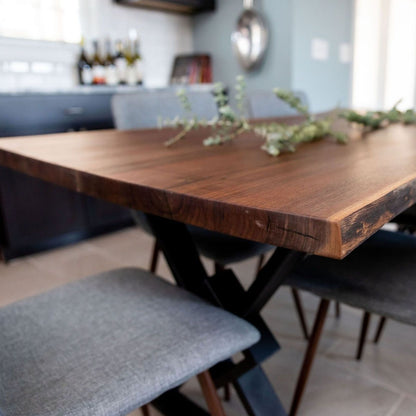From Typical to Modern: Discover the Perfect Dining-room Table Legs for Your Style
While traditional layouts such as cabriole and transformed legs stimulate a sense of ageless sophistication, contemporary designs like hairpin and geometric choices provide an opportunity for striking aesthetic rate of interest. As you take into consideration these aspects, the question stays: how can you flawlessly integrate these diverse leg styles to produce an unified dining experience?
Comprehending Table Leg Styles
The variety of eating room table leg styles can substantially affect both the visual appeals and capability of the room. Each leg style contributes special functional functions and visual components, providing to varied design preferences and use needs. Recognizing these styles is crucial for picking the appropriate dining table that straightens with your total indoor style vision.
For example, tapered legs provide a tidy, timeless appearance that can enhance an area's beauty, while pedestal bases supply stability and make the most of legroom, making them ideal for smaller sized areas. Barrette legs, a trademark of mid-century modern layout, introduce an industrial flair, permitting a ventilated, open feeling. Trestle legs stimulate rustic beauty, offering robust assistance and a sense of eternity.
Additionally, the selection of products plays a considerable duty. Wood legs can bring warmth and texture, whereas metal choices frequently communicate a smooth, contemporary ambiance. Inevitably, recognizing table leg designs is necessary for developing a natural eating area that mirrors personal design while guaranteeing usefulness and convenience. By thoughtfully thinking about these components, you can enhance both the functional and aesthetic charm of your dining space.
Standard Table Leg Options
When selecting dining-room table legs, standard choices typically personify ageless beauty and craftsmanship. These layouts show a rich heritage and a dedication to high quality, making them optimal for those that appreciate traditional aesthetics.
Among one of the most iconic standard leg designs is the cabriole leg, defined by its stylish rounded form. This design usually features decorative makings and is most frequently located in Queen Anne and Chippendale furnishings. Another prominent choice is the turned leg, which flaunts a collection of smooth, rounded shapes that supply a classic look while preserving stability.
In addition, the straight leg, while straightforward, supplies a strong and unadorned framework that can blend effortlessly with a selection of tabletop designs. For those drawn to ornate describing, claw-and-ball feet legs stimulate a sense of splendour and can function as a stunning centerpiece in any kind of dining room.
Finally, stand bases, although not strictly legs, offer a different traditional option that permits for sufficient legroom and can be magnificently sculpted. Each of these standard leg styles adds to the total ambiance of an eating room, weding feature with aesthetic charm.

Modern Table Leg Layouts
Modern table leg layouts provide a diverse variety of designs that Get the facts highlight cutting-edge products and tidy lines. These styles frequently prioritize performance while acting as striking focal points within a dining area. Minimal looks are widespread, with legs crafted from products such as metal, glass, and crafted wood, which contribute to a airy and contemporary feel.
One prominent design is the barrette leg, characterized by its slender, tapered structure that supplies security without overwhelming the table top (dining room table legs). This style is often discovered in mid-century modern furnishings and can effortlessly match different dining table shapes. One more fad is using geometric shapes, where legs may take on asymmetrical or angular types, adding visual rate of interest and a touch of artistry

Mixing Designs for Unique Rooms
Commonly, home owners seek to create one-of-a-kind dining spaces that show their personal style by blending numerous layout components. This visit their website technique enables for the incorporation of diverse visual appeals, resulting in a harmonious yet unique setting. As an example, matching a rustic wooden table with streamlined, contemporary steel legs can develop an attractive contrast that boosts the space's total appeal.
Additionally, incorporating vintage table legs with contemporary table tops can stimulate a sense of background while preserving a modern-day sensibility. Such mixes not just showcase individual taste however likewise encourage imagination, permitting homeowners to curate a room that really feels both personal and inviting.
Shade plays an essential function in this mixing process; picking table legs that enhance or comparison with the existing color design can improve aesthetic passion. For example, whitewashed legs can soften the daring of a dark table surface, developing a balanced visual.
Tips for Picking the Right Legs
Selecting the right table legs is necessary for accomplishing both capability and aesthetic appeal in your dining space. Begin by thinking about the overall design of your room. Conventional setups benefit from legs that include elaborate makings or transformed designs, while contemporary rooms may ask for sleek, minimal designs.
Following, evaluate the elevation and stability of the legs. dining room table legs. Standard table range between 28 to 30 inches in height, so guarantee the legs enhance this why not check here dimension for convenience. In addition, durable materials, such as wood or steel, can enhance security and longevity
Assess the leg form too-- options include straight, tapered, or stand designs. Straight legs offer a timeless appearance, while conical legs can include a touch of style. Pedestal bases supply sufficient legroom and are perfect for smaller sized rooms.
Verdict
In summary, choosing the perfect dining-room table legs calls for cautious factor to consider of both modern-day and typical styles. Standard options such as cabriole and turned legs supply timeless sophistication, while modern styles like hairpin and geometric shapes offer a modern touch. By balancing leg style, elevation, and product with the overall décor, a cohesive and inviting atmosphere can be attained. Ultimately, the selected table legs need to mirror the desired visual, boosting the dining experience within the space.
The variety of eating area table leg styles can substantially affect both the appearances and performance of the room. Inevitably, comprehending table leg designs is essential for developing a cohesive dining area that shows personal style while guaranteeing functionality and comfort.One of the most famous typical leg designs is the cabriole leg, defined by its stylish bent shape. Straight legs offer a classic look, while conical legs can add a touch of style.In recap, choosing the perfect dining room table legs requires cautious factor to consider of both conventional and modern styles.
 Jonathan Lipnicki Then & Now!
Jonathan Lipnicki Then & Now! Judge Reinhold Then & Now!
Judge Reinhold Then & Now! Earvin Johnson III Then & Now!
Earvin Johnson III Then & Now! Jane Carrey Then & Now!
Jane Carrey Then & Now! Nicholle Tom Then & Now!
Nicholle Tom Then & Now!